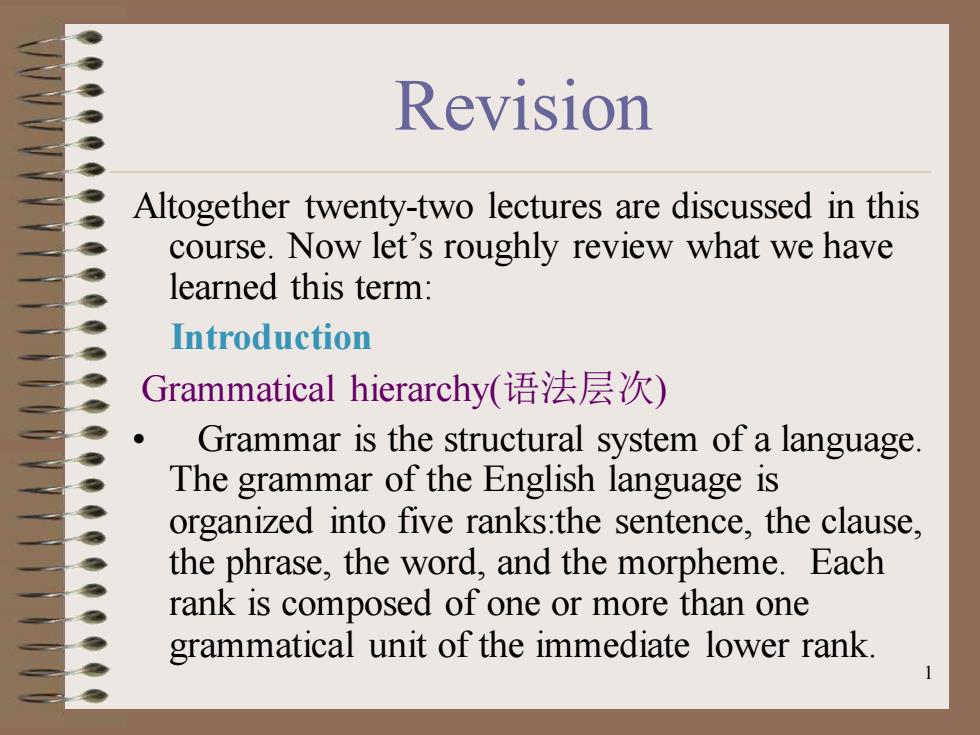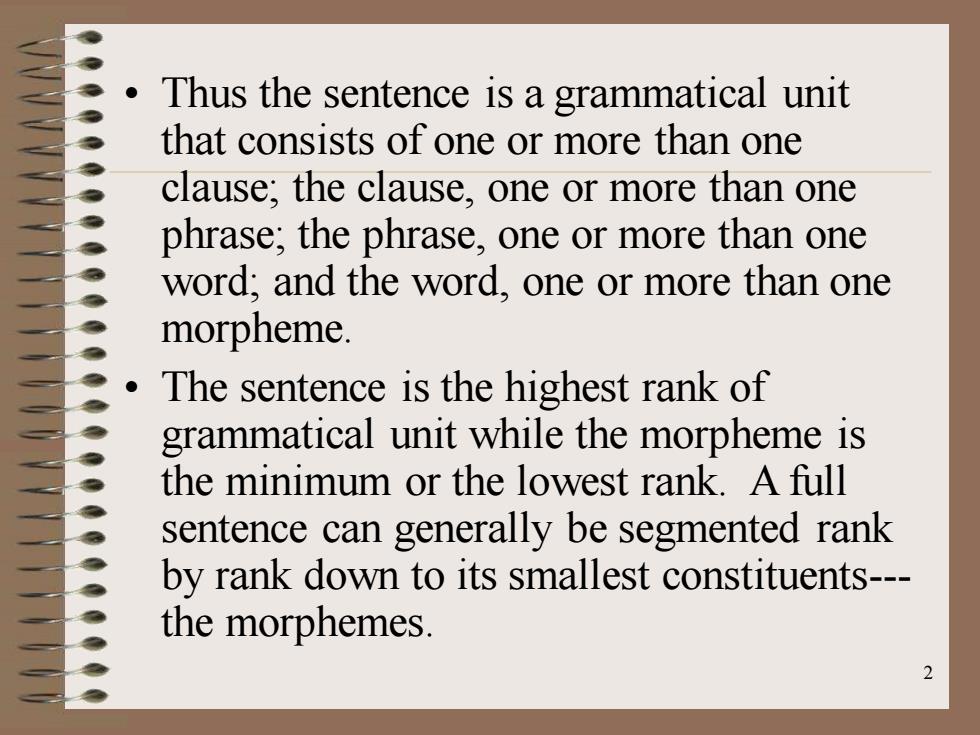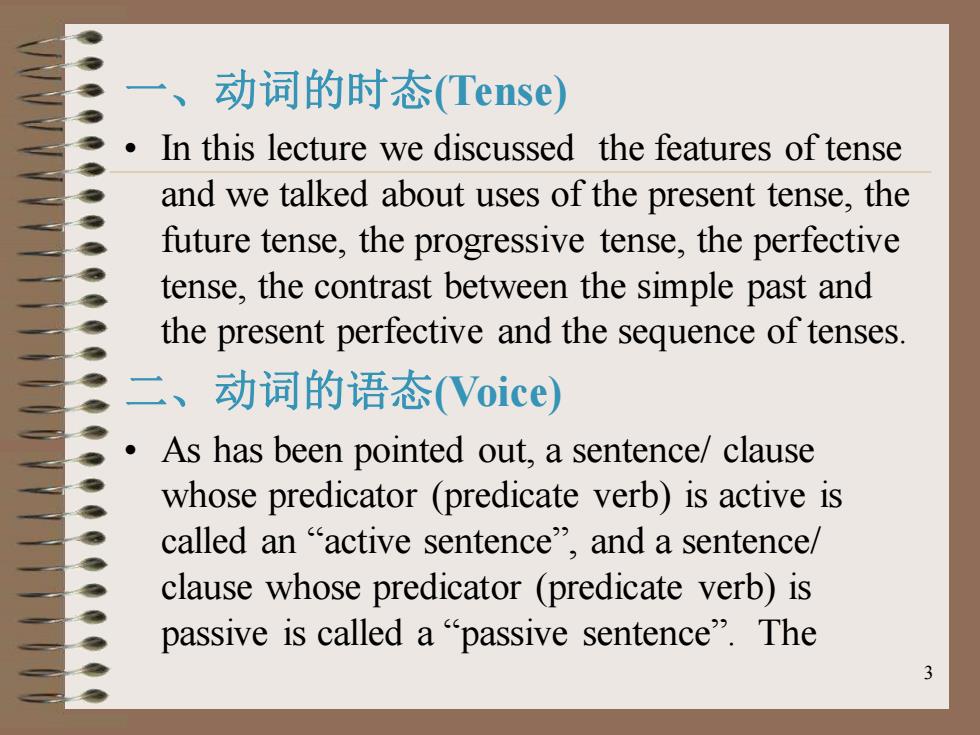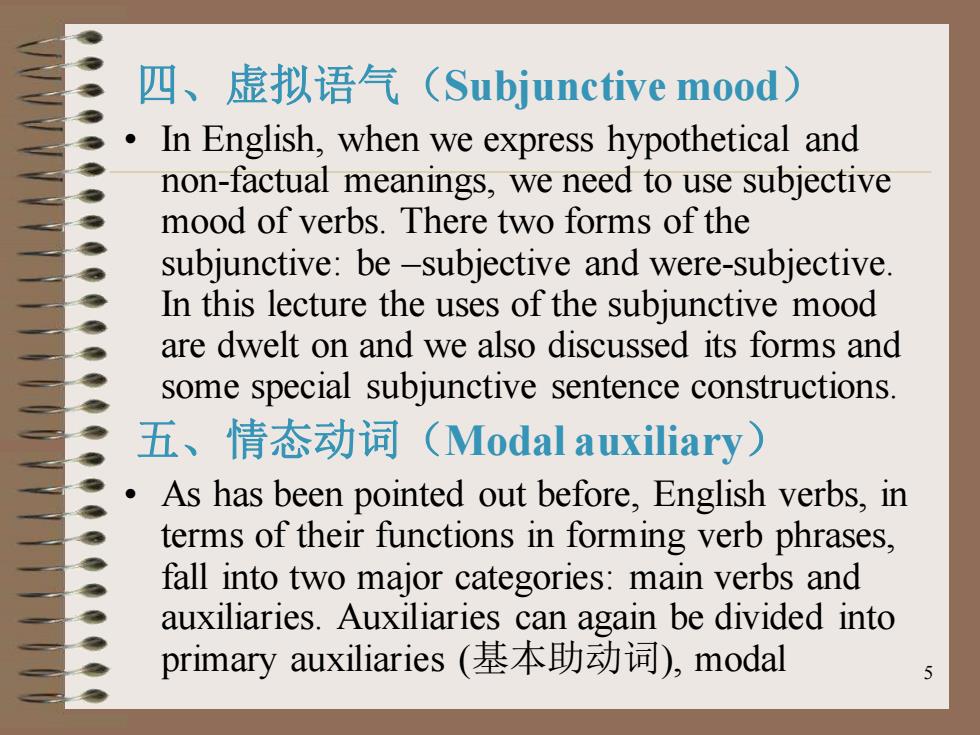
Revision Altogether twenty-two lectures are discussed in this course.Now let's roughly review what we have learned this term: Introduction Grammatical hierarchy(语法层次) Grammar is the structural system of a language. The grammar of the English language is organized into five ranks:the sentence,the clause, the phrase,the word,and the morpheme.Each rank is composed of one or more than one grammatical unit of the immediate lower rank
1 Revision Altogether twenty-two lectures are discussed in this course. Now let’s roughly review what we have learned this term: Introduction Grammatical hierarchy(语法层次) • Grammar is the structural system of a language. The grammar of the English language is organized into five ranks:the sentence, the clause, the phrase, the word, and the morpheme. Each rank is composed of one or more than one grammatical unit of the immediate lower rank

Thus the sentence is a grammatical unit that consists of one or more than one clause;the clause,one or more than one phrase;the phrase,one or more than one ●● word;and the word,one or more than one morpheme. The sentence is the highest rank of grammatical unit while the morpheme is the minimum or the lowest rank.A full sentence can generally be segmented rank by rank down to its smallest constituents--- the morphemes. 2
2 • Thus the sentence is a grammatical unit that consists of one or more than one clause; the clause, one or more than one phrase; the phrase, one or more than one word; and the word, one or more than one morpheme. • The sentence is the highest rank of grammatical unit while the morpheme is the minimum or the lowest rank. A full sentence can generally be segmented rank by rank down to its smallest constituents--- the morphemes

动词的时态(Tense) In this lecture we discussed the features of tense and we talked about uses of the present tense,the future tense,the progressive tense,the perfective tense,the contrast between the simple past and the present perfective and the sequence of tenses. 二、 动词的语态Voice) As has been pointed out,a sentence/clause whose predicator (predicate verb)is active is called an“active sentence”,and a sentence/ clause whose predicator (predicate verb)is passive is called a "passive sentence".The
3 一、动词的时态(Tense) • In this lecture we discussed the features of tense and we talked about uses of the present tense, the future tense, the progressive tense, the perfective tense, the contrast between the simple past and the present perfective and the sequence of tenses. 二、动词的语态(Voice) • As has been pointed out, a sentence/ clause whose predicator (predicate verb) is active is called an “active sentence”, and a sentence/ clause whose predicator (predicate verb) is passive is called a “passive sentence”. The

subject in the active sentence is the agent or doer of an action,and in the passive the recipient of the action. In this lecture we discussed the use of active voice and passive voice and some special points that we should pay much attention to verb voices. 三、非谓语动词Non-finite forms) English verb have three non-finite forms: infinitive,participles and gerund.In this lecture we talked about the uses of different non-finite forms or types,their tense and their voices,some non-finite patterns and exceptions
4 • subject in the active sentence is the agent or doer of an action, and in the passive the recipient of the action. • In this lecture we discussed the use of active voice and passive voice and some special points that we should pay much attention to verb voices. 三、非谓语动词(Non-finite forms) • English verb have three non-finite forms: infinitive, participles and gerund. In this lecture we talked about the uses of different non-finite forms or types, their tense and their voices, some non-finite patterns and exceptions

四、虚拟语气(Subjunctive mood) In English,when we express hypothetical and non-factual meanings,we need to use subjective mood of verbs.There two forms of the subjunctive:be-subjective and were-subjective In this lecture the uses of the subjunctive mood are dwelt on and we also discussed its forms and some special subjunctive sentence constructions. 五、情态动词(Modal auxiliary) As has been pointed out before,English verbs,in terms of their functions in forming verb phrases, fall into two major categories:main verbs and auxiliaries.Auxiliaries can again be divided into primary auxiliaries(基本助动词),modal
5 四、虚拟语气(Subjunctive mood) • In English, when we express hypothetical and non-factual meanings, we need to use subjective mood of verbs. There two forms of the subjunctive: be –subjective and were-subjective. In this lecture the uses of the subjunctive mood are dwelt on and we also discussed its forms and some special subjunctive sentence constructions. 五、情态动词(Modal auxiliary) • As has been pointed out before, English verbs, in terms of their functions in forming verb phrases, fall into two major categories: main verbs and auxiliaries. Auxiliaries can again be divided into primary auxiliaries (基本助动词), modal